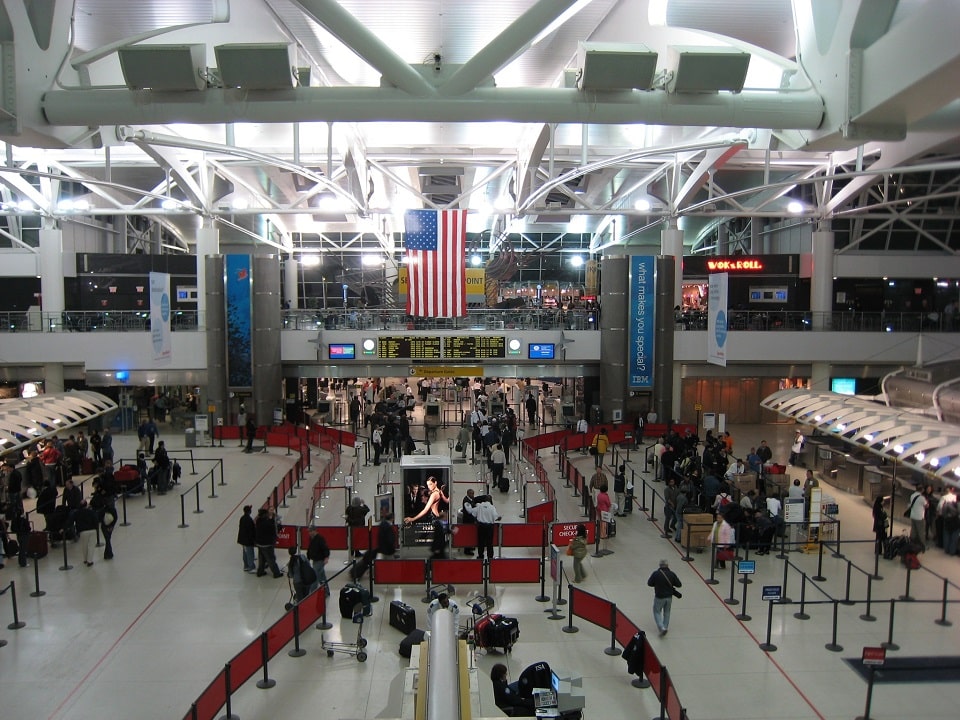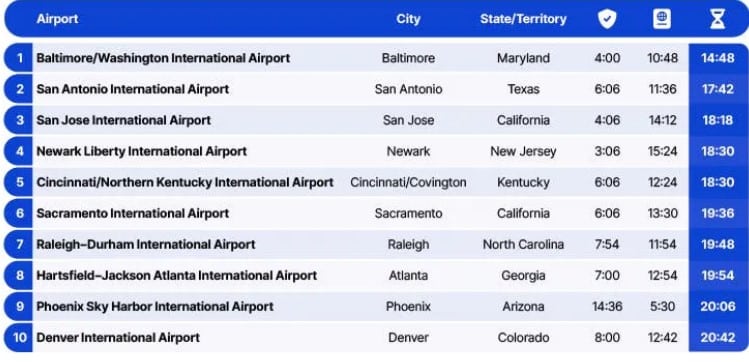Airlines
Which US Airports Have the Longest and Shortest Wait Times in 2023?

Travelers have legitimate concerns about the potential air travel portion of their travels with the busy summer season rapidly approaching. The extremely long lines at airports and the frequent and extensive flight delays we experienced in 2023. The summer season often brings an increase in passenger volumes, leading to crowded terminals, longer queues, and potential delays.
In the midst of the anticipation, luggage storage company Bounce conducted a timely new study, analyzing the average time it takes to get through a number of the country’s major airports, including passing through TSA security checks and passport control points—to identify the U.S. airports that currently have the longest and shortest security passenger wait times.
U.S. airports with the longest wait times
- John F. Kennedy International Airport: Taking the top spot is New York’s JFK International Airport. The current average wait time for security is 22 minutes, 48 seconds. You will also need to spend 25 minutes, 36 seconds in passport control, for a total of 48 minutes, 24 seconds. JFK handles a lot of both domestic and international travelers as one of the busiest airports in the US. Longer lines at passport control and security checkpoints result from increased pressure on the infrastructure and staff at the airport.
- San Francisco International Airport, California: It had a total wait time of 47 minutes, 18 seconds. SFO is a major entry point for international travel, especially from Asia and Europe. However, the large number of international travelers strains the security and passport control procedures. Similarly to this, the layout and space constraints of the airport can lead to bottlenecks and lengthen wait times.
- Miami International Airport, Florida: The combined average wait time at Miami International Airport is 45 minutes and 54 seconds, placing it third overall. As an important hub for flights to and from Latin America and the Caribbean, MIA sees a sizable influx of visitors from abroad. This can result in longer lines at passport control.
- Fort Lauderdale–Hollywood International Airport, Florida: The airport with the longest average wait for passport control is Fort Lauderdale-Hollywood International, where the wait time is 25 minutes and 54 seconds. One of the busiest airports in the world, JFK, is just a few seconds slower than that. Passport control lines can get busy because of the large passenger volume, especially during the busiest travel hours.

U.S. airports with the shortest wait times
- 1. Baltimore/Washington International Airport, Maryland: Passengers fly through security and passport checks here with a cumulative wait time of just 14 minutes and 48 seconds. Fewer passengers could mean shorter lines at passport control and security.
- 2. San Antonio International Airport, Texas: With a total wait time of 17 minutes and 42 seconds, San Antonio comes in second. SAT, which is based in Uptown Central San Antonio, Texas, sees less passenger flow because it is not a significant airline hub. The airport predominantly handles domestic flights, which can result in shorter lines at security and passport check.
- 3. San Jose International Airport, California: It had a cumulative wait time of 18 minutes and 18 seconds, round off at the top three. Lessening wait times may be a result of the decreased passenger volume and the fact that business travelers are more familiar with the security processes.
- 4. Newark Liberty International Airport, New Jersey: It has the shortest three minute, six-second average security wait. Despite the fact that Newark serves as a significant hub for both domestic and foreign aircraft, the wait times for security do not reflect this. This might be the result of effective planning and construction, as well as cutting-edge security tools like CT scanners and automated screening lanes.


Airlines
Air India Rolls Out A350s for Delhi-New York JFK and Newark Routes

In a major development for North American travelers, Air India has announced the deployment of its state-of-the-art Airbus A350-900 aircraft on two key routes: Delhi to New York and Delhi to Newark.
The service on the Delhi-New York route will commence on November 1, 2024, while the Delhi-Newark route will see its inaugural flight on January 2, 2025.
The introduction of the air india a350 will bring significant enhancements to Air India’s offerings, particularly with the launch of its Premium Economy class. air india retrofit This new class will feature 24 wide seats arranged in a 2-4-2 configuration, providing passengers with extra legroom and a more comfortable flying experience.
Soon, Air India aircraft will feature onboard WiFi & all-new cabins: Click here
“We are encouraged by the positive guest feedback we have received from the domestic deployment of our air india a350 interior to offer our hero product on the Delhi-New York JFK and Delhi-Newark routes. This is a significant leap forward for our U.S. operations that also underscores our commitment to continuous improvement,” said Campbell Wilson, Chief Executive Officer & Managing Director of Air India.
The A350’s Business class will set new standards with 28 private suites, each equipped with full-flat beds, direct aisle access, and personal wardrobes. Economy class will be configured to accommodate 264 passengers in a 3-4-3 layout. Across all cabins, passengers will enjoy the latest Panasonic eX3 in-flight entertainment system, offering over 2,200 hours of content.
Air India’s First A350-900: Interior, Routes, &Inflight Features: Click here
This strategic deployment marks a notable enhancement in Air India’s U.S. operations, with 60% of its flights to the U.S. now featuring new or upgraded cabin interiors. The air india new international routes currently operates 51 weekly flights to five U.S. destinations: New York JFK, Newark, Washington DC, Chicago, and San Francisco.
The revamped cabins, advanced in-flight entertainment systems, and improved service standards represent air india wifi commitment to providing a superior travel experience. “We believe this enhanced offering will solidify Air India’s position as a leading carrier and attract travellers seeking a world-class flying experience between India and the United States,” the airline stated.
Seats on these flights are now available for booking on Air India’s website, mobile app, and through travel agents, ensuring that passengers can easily plan their journeys on these newly upgraded routes.
Air India Economy vs Qatar airways economy: which is best?:Click here
-

 Travel1 week ago
Travel1 week agoAir India to Expand US Operations with Three New Routes After a Decade
-

 Travel2 weeks ago
Travel2 weeks agoWhy We Should Avoid These Stamps in a Passport
-

 Airlines1 month ago
Airlines1 month agoInvestigations Reveal Fake Chinese Titanium in Boeing and Airbus Jets
-

 Tech4 weeks ago
Tech4 weeks agoChina’s CATL Plans 1,800-Mile Electric Plane Launch by 2027
-

 Airport3 days ago
Airport3 days agoTop 10 Largest Airports in the World by Size
-

 Aerospace4 weeks ago
Aerospace4 weeks agoChina’s Fighter Jets Turn Wings into Autonomous Drones
-

 Airlines4 days ago
Airlines4 days agoAir India Rolls Out A350s for Delhi-New York JFK and Newark Routes
-

 Defence3 weeks ago
Defence3 weeks agoBoeing Enhances Chinook with New Engines and Block II Upgrades at $96 Million







